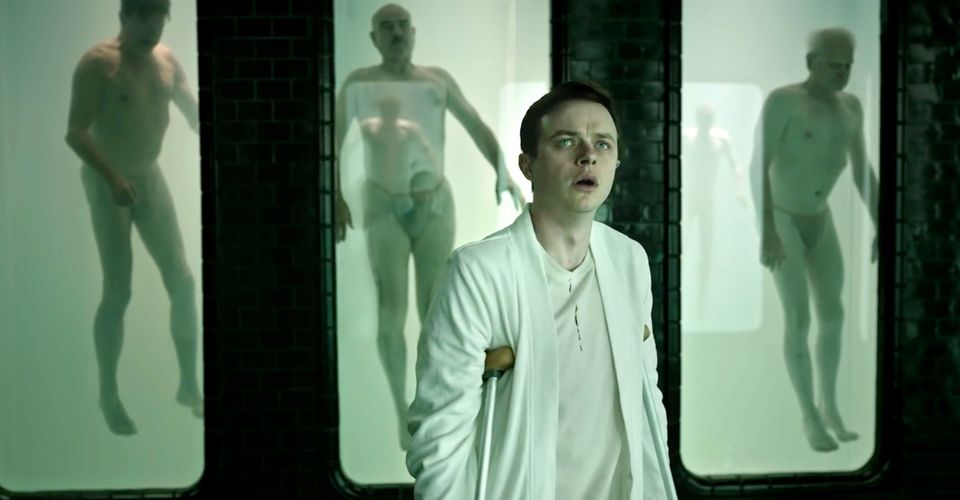A Cure For Wellness’ Ending Explained

Warning: Major SPOILERS for A Cure For Wellness ahead
–
A Cure For Wellness is a movie that’s constantly juggling several different identities and narrative threads. Ostensibly a story about a Wall Street upstart named Lockhart (Dane Dehaan) who tries to retrieve his missing boss from an isolated health spa (The Volmer Institute) in the Swiss Alps, only to find himself injured and confined to the increasingly-sinister “wellness center” himself as a patient, it quickly unfolds into (in no particular order): a psychological thriller, a dreamlike “gaslighting” melodrama, a murder mystery, a gothic horror film and ultimately something like a science-fiction monster movie. This is topped off with an ending that piles on the shocks, surprises, gross-out gore so enthusiastically that it’s easy to lose track of what’s supposed to have been going on.
Also eels. Lots and lots of eels.
Have you seen A Cure For Wellness? Do you still have questions? Let’s try and unpack a few of them:
What was actually going on?

Short version: Jason Isaacs’ Dr. Heinreich Volmer, though introduced as the unconventional head of the wellness spa, was actually a medically-immortal Swiss Baron and mad scientist supposedly executed 200 years prior. Volmer has been kept alive and seemingly ageless thanks to a supposedly vitamin-based curative potion that he and his staff/followers have been creating by manipulating the bodies of the spa’s largely wealthy patients. Unusually young patient Hannah (Mia Goth) was actually his similarly slow-aging daughter, born at the moment of his supposed execution. The eels and the patients had been positioned into an (artificially-induced) symbiotic life-cycle that was the actual source of Volmer’s fountain-of-youth “vitamins;” primarily by being fed to one another.
Make sense? No? Okay, let’s get a bit more specific:
The Backstory

When Lockhart arrives at the Volmer Institute, he’s informed that the locals of the impoverished town at the base of the mountain where the castle-like spa has been built are suspicious of the place (as in any good gothic horror story about a mad scientist), due to unspeakable events that serve as the local boogeyman story. 200 years ago, The Institute was the castle of a notoriously mad Baron who fell in forbidden love with his own sister – who was said to have been stricken with an incurable illness. Seeking to cure her, he began conducting unnatural medical experiments on the local peasantry, resulting in the discovery of seemingly “mummified” corpses and a Frankenstein-style pitchforks n’ torches raid on the castle, wherein both siblings were burned alive and the original castle was mostly destroyed.
Some time later (early 20th century, going by the architecture and equipment design), Dr. Volmer’s predecessors are said to have purchased the land for medical and rehabilitation use, centered on the reputed rejuvenative properties of the “holy waters” in the cavernous natural aquifer located within the mountain itself – with Volmer himself having refined it into an exclusive private spa for the rich and anxiety-ridden in his era. Apart from Lockhart (who is a “patient” owing to his broken leg) and the enigmatic teenager Hannah, all of the patients are ultra-wealthy businesspeople seeking relief from the stress brought on by guilt over their over-consumptive lifestyles.
Lockhart also befriends an older female patient who has appointed herself the amateur historian of the place, who offers the “unedited” version of the Baron’s story: He wasn’t simply “in love” with his sister – he was a quasi-fascist convinced of the genetic superiority of his own bloodline and was obsessed with fathering similarly-“pure” children through inbreeding. The “illness” his sister suffered from was actually infertility, and that’s what he’d been trying to cure. What’s more, he’d actually succeeded! The sister/wife had become pregnant, but in the attack by the peasants the child was supposedly forcefully-aborted and drowned alive in the underground spring.
However, while exploring Volmer’s office, Lockhart takes note of a framed (later revealed to also have been cropped-out) photograph from the construction of the Institute where he notes a man with his face bandaged like that of a burn victim hanging out on the grounds with a young girl in tow – guess who?
What Was Volmer Planning?

If you weren’t sufficiently grossed-out already: Volmer is keeping Hannah (who doesn’t know the true nature of their relationship) on a managed-dose of the youth-elixir in order to (gradually) age her into adulthood; the ultimate goal being to pick up where he left off with her mother (his sister) i.e. fathering a Master Race of inbred genetically-superior supermen. The only reason he hasn’t started already is because, while she’s technically “of age,” all this biological tampering has slowed the onset of puberty – and therefore her ability to bear children.
What sets things in motion, apparently, is Lockhart. Meeting a boy (roughly) her own age and flirting with him (and, less advisedly, some local toughs at a bar in town) appears to jump-start Hannah’s pubescence. She gets her first period shortly after trekking with him to town so he can inquire about smuggled medical records (see below), which Volmer and his cult-like followers take as a cue to stage another big wedding ceremony… followed by a decidedly non-consensual consummation from which Lockhart attempts to rescue her in the big climax.
What about the eels?

Eels are the big nightmare-imagery signifier in A Cure For Wellness. Lockhart has dreams about them, he hallucinates (or maybe not) being attacked by a swarm of them while floating in a sensory-depravation tank, and he even has a vision of Hannah reclining naked in a bathtub full of them. The creatures seem to be “haunting” the plumbing of The Institute, slithering in and out of bathroom fixtures, and we ultimately discover that Volmer/The Baron has an old-fashioned mad scientist lab down in the aquifer caverns where he dissects and studies them intensely. As you might have already guessed, these are no ordinary eels – they’re a unique species that breeds and lives (by the thousands) in the aquifer springs themselves.
What’s so special about them? Well, it turns out the aquifer’s “holy water” is actually not very healthy at all for human consumption – but it extends the lifespan of the eels to over 300 years. The Baron had sought to extract whatever made this reaction possible for human use by forcing live eels down the throats (and into the stomachs) of human subjects, and then extracting concentrated liquid from said subject’s bodies over time in order to create his life-prolonging “vitamin” elixir (which, Lockhart had previously noted, “tastes like sweaty fish”). This explains the “mummified” bodies in the Baron’s time, and the redacted medical records showing patients suffering from chronic dehydration in Volmer’s time – where, additionally, the eventual deaths of the patients are covered-up by feeding their remains to the eels.
The “spa” concept, then, is Volmer’s means of not repeating his Baron-era mistakes. Instead of drawing attention by kidnapping people, he’s taking advantage of the existential angst of 21st Century titans of capitalism in order to keep them guzzling (and swimming, bathing, showering and lord knows what else in) the aquifer’s “miracle water,” and becoming vitamin-factories willingly as part of the “treatment” they’ve been gaslit into believing they require.
What’s it really about?

You’ll probably want to ask director Gore Verbinski about that, but at least in the broad strokes the film makes it pretty clear that this is all meant to be a metaphor for an over-medicated, over-analyzed modern life – specifically the idea that The Institute’s wealthy “patients” would rather believe in a mad scientist’s diagnosis of imagined physical ailment (and the bizarre treatments it supposedly requires) than ask whether it’s the world they inhabit, the culture they create, or just they themselves that are really making them feel unwell.
This narrative subtext is made text when, at the climax, Lockhart is struck by a sudden realization of just how much he’d been listening to Volmer’s pronouncements himself and cuts off his cast – discovering that his leg was never actually broken. But it’s also there in Volmer’s mad quest to “cure” his inability to create an inbred master-race at the expense of his victims. In a sense, the final message of A Cure For Wellness would appear to be: Get a second opinion.
Next: Dane DeHaan Discusses A Cure for Wellness’ Toughest Scene
- A Cure for Wellness (2017)Release date: Feb 17, 2017

















